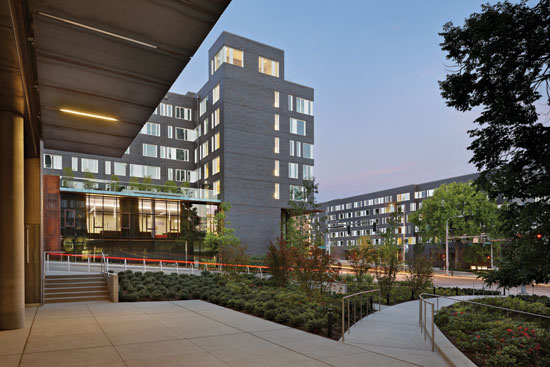Multi-Story Wood Construction
Innovative Wood Products and Building Systems
A number of innovative technologies and building systems are increasing the opportunities for mid-rise wood buildings. For example:
Prefabricated Systems
Specifying prefabricated or factory manufactured wall and roof panels can provide better quality wall construction since the panels are created off-site in moisture controlled environments. Wall panelizing is particularly useful for jobsites that don't have adequate space to construct the walls and can speed the erection time considerably. Wall panels can also optimize stud design and increase sound proofing and energy efficiency. Panels may range from 4 to 30 feet long, and are lifted into place by crane.
Cross Laminated Timber (CLT)
Cross laminated timber is a multi-layer wood panel in which each layer is oriented crosswise to its adjacent layer for increased dimensional stability and structural performance. Widely used in Europe and now available in North America, it is considered viable for buildings up to 12 stories and even higher.
In Australia, CLT has been used to create a 10-story all-wood building, while eight-story examples exist in the U.K. and Austria. North American applications include (among others) a two-story commercial building in Montana, and a five-story heavy timber/CLT hybrid building at the University of British Columbia.
Among CLT's attractive structural characteristics are high dimensional stability, high axial load capacity, high shear strength, rigidity around openings and negligible settlement effects. CLT assemblies also offer inherent fire resistance due to thick cross-sections that, when exposed to fire, char at a slow and predictable rate, and the ability to resist lateral loads caused by earthquakes or high winds. Other benefits include speed of construction, thermal performance, and the environmental advantages offered by all wood products—including a low carbon footprint.8
Based on recent code change approvals, the 2015 IBC will identify CLT as a structural product and recognize it for use in Type IV exterior walls, floors and roofs. However, while the 2015 IBC won't go into effect in most jurisdictions until 2016, designers can pursue the use of CLT under the alternate means and methods approach in the current code. For more information, APA (www.apawood.org) has developed an American National Standard, ANSI/APA PRG 320 2011: Standard for Performance Rated Cross-Laminated Timber.
Conclusion
The last few years have seen a trend toward taller wood buildings, driven by their acceptance in building codes and the value they provide. Design professionals are capitalizing on wood's ability to offer high density at less cost than other materials. They also appreciate wood's versatility, adaptability and light carbon footprint. However, while today's building codes recognize wood's safety and performance capabilities in buildings that are five and six stories—and these are becoming increasingly common—innovative technologies such as CLT can be expected to propel designers of mid-rise wood buildings to even greater heights.
Endnotes
- Life Cycle Environmental Performance of Renewable Building Materials in the Context of Building Construction, Consortium for Research on Renewable Industrial Materials, Phase I 2005, Phase II 2010; A Synthesis of Research on Wood Products and Greenhouse Gas Impacts, Sarthre, R. and J. O'Connor, 2010, FPInnovations; Werner, F. and Richter, K. 2007, Wooden building products in comparative LCA: A literature review, International Journal of Life Cycle Assessment
- See endnote 1.
- The carbon calculator was developed by FPInnovations, WoodWorks and the Canadian Wood Council; available at www.woodworks.org
- Case study, http://woodworks.org/wp-content/uploads/Stella-CaseStudy-WEB.pdf
- O'Connor, J., 2004, Survey on Actual Service Lives for North American Buildings, FPInnovations
- Case study: All-wood Podiums in Midrise Construction, APA, www.apawood.org/level_c.cfm?content=pub_searchresults&pK=wood%20podium&pT=Yes&
pD=Yes&pF=Yes&pubGroup= - www.youtube.com/watch?v=c25HuZeQsyo&context=C3f612acADOEgsToPDskLH3EQs-aodM9-NsZgF2lGi
- U.S. CLT Handbook,www.masstimber.com/products/cross-laminated-timber-clt/handbook
 |
The reThink Wood initiative is a coalition of interests representing North America's wood products industry and related stakeholders. We share a passion in wood and the forests they come from. Innovative new technologies and building systems have enabled longer wood spans, taller walls and higher buildings, and continue to expand the possibilities for wood use in construction. www.rethinkwood.com |
 |
WoodWorks is an initiative of the Wood Products Council established to provide free one-on-one project support, education and resources related to the design of non-residential and multi-family wood buildings. If you have a project that requires technical expertise in wood design, contact help@woodworks.org. www.woodworks.org |









